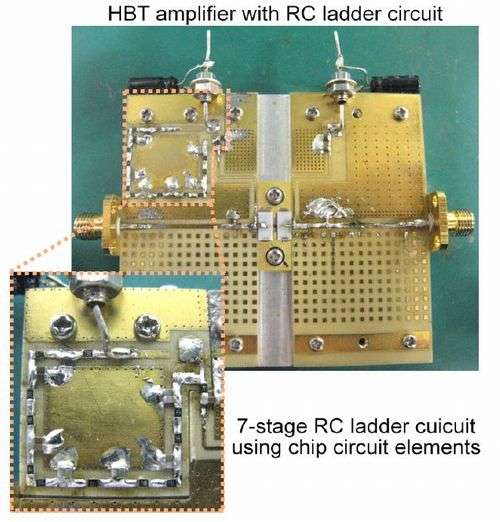A fabricated InGaP/GaAs heterojunction bipolar transistor amplifier at 1.95 GHz including a thermal memory effect compensation circuit.
As circuits become smaller and more densely populated with circuit elements, electrical characteristics of the components become more prone to the influence of the heat generated. "The interaction between thermal and electrical phenomena is one of the most troublesome problems in analog and digital integrated circuits," explain Ryo Ishikawa, Junichi Kimura and Kazuhiko Honjo from the University of Electro-communications in Chofu-shi, Japan.
In this paper, the researchers report on the world's first method to compensate the disturbed electrical characteristics by using an electric circuit that cancels signal distortion caused by thermal behaviour of a heterojunction bipolar transistor. This research should help design devices that are better equipped to handle heat effects.
A modulated high-frequency signal is distorted by the thermal behaviour through complex intermodulation phenomena, although the temperature response of the circuit is slow. The researchers modelled the thermal effects of a heterojunction bipolar transistor in an integrated circuit using thermal resistors and thermal capacitors. The circuit elements were arranged in a 'ladder circuit' comprising repeating units of thermal resistors and thermal capacitors. To compensate the signal distortion on the integrated circuit, an electric 'ladder circuit' was connected.
Although the validity of the electric ladder circuit to compensate the signal distortion has already been confirmed by experiments and simulations, a theoretical derivation for the behaviour has so far been lacking. Honjo and his team derived nonlinear expressions describing the circuit parameters, and solved the expressions using series expansions. The model compared well with experiments and simulations.
Experiments for an InGaP/GaAs heterojunction bipolar transistor power amplifier operating at 1.95GHz provide compelling validation for their analytical design, emphasising its potential for designing circuits that cope better with heat effects.
More information: Ishikawa R, Kimura J and Honjo K Analytical design method for a low-distortion microwave InGaP/GaAs HBT amplifies based on transient thermal behaviour in a GaAs substrate IEEE Transactions on components, packaging and Manufacturing Technology 3, 1705-1712 (2013) DOI: 10.1109/TCPMT.2013.2262504
Provided by University of Electro Communications























